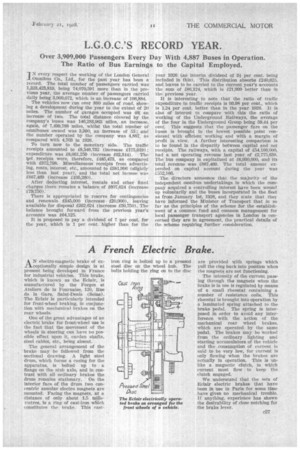A French Electric Brake.
Page 49

If you've noticed an error in this article please click here to report it so we can fix it.
AN electro-magnetic brake of exceptionally simple design is at present being developed in France for industrial vehicles. This brake, which is known as the Eclair, is manufactured by the Forges et Ateliers de la Fouruaise, 120, Rue de In Care, Saint-Denis (Seine). The Eclair is particularly intended for front-wheel braking, in conjunction with mechanical brakes on the rear wheels.
One of the great advantages of an electric brake for front-wheel use is the fact that the movement of the wheels in steering can have no possible effect upon it, cardan shafts, steel cables, etc., being absent.
The general arrangement of the brake may be followed from the sectional drawing. A. light steel drum, which forms a casing for the apparatus, is bolted up to a flange on the stub axle, and in contrast with all ordinary brakes the drum remains stationary. On the interior face of the drum two concentric annular electro magnets are mounted. Facing the magnets, at a distance of only about 1.5 minemetres, is a ring of east-iron which constitutes the brake. This cast iron ring is bolted up to a pressed steel disc on the wheel hub. The bolts holding the ring on to the disc
are provided with springs which pull the ring back into position when -the magnets are not functioning.
The intensity of the current passing through the magnets when the brake is in use is regulated by means of a small rheostat containing a number of resistance coils. This rheostat is brought into operation by a laminated spring attached to the brake pedal. The spring is interposed in order to avoid any interference with the action of the mechanical rear wheel brakes, which are operated by the same pedal. The brakes may be worked from the ordinary lighting and starting accumulators of the vehicle and the .consumption of current is said to be very low, for current is only flowing when the brakes are actually in operation. This is unlike a magnetic 'clutch, ill which current must flow to keep the clutch engaged.
We understand that the aets of Eclair electric brakes that have been in use in Paris for some time have given no mechanical trouble. If anything, experience has shown the desirability of close notching for the brake lever.












































































































